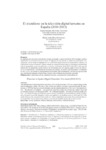El pluralismo en la televisión digital terrestre en España (2010-2013)

Ver/
Use este enlace para citar
http://hdl.handle.net/2183/16146Coleccións
- II - Artigos [544]
Metadatos
Mostrar o rexistro completo do ítemTítulo
El pluralismo en la televisión digital terrestre en España (2010-2013)Título(s) alternativo(s)
Pluralism in Spain’s Digital Terrestrial Television (2010-2013)Data
2015Cita bibliográfica
MONTERO SÁNCHEZ, María Dolores; DÍAZ GONZÁLEZ, María Jesús; y QUINTAS FROUFE, Natalia (2015): “El pluralismo en la televisión digital terrestre en España (20102013)”. Estudios sobre el Mensaje Periodístico. Especial noviembre “Periodismo e información de calidad”, págs.: 209229. Madrid, Servicio de Publicaciones de la Universidad Complutense.
Resumo
[Resumen]: La implantación de la televisión digital terrestre en España, a partir de abril de 2010 introdujo cambios importantes en el sistema televisivo estatal. El objetivo de este artículo es analizar las principales consecuencias que ha tenido la implantación de la televisión digital terrestre en el pluralismo externo y en
el pluralismo interno informativo. Hemos tomado en consideración tres tipos de indicadores de pluralismo externo (propiedad, cuotas de audiencia e inversión publicitaria) desde 2010 hasta 2013 y dos tipos de indicadores del pluralismo interno (índices de correlación entre las cadenas según el orden de relevancia de la información y distribución de los temas por cadenas, en ambos casos aplicados a los titulares) en 2012 y 2013. Se discute la correspondencia entre ambos tipos de pluralismo y se concluye que no existe
una relación determinante del pluralismo externo sobre el interno en el período analizado. [Abstract]: The introduction of digital terrestrial television (DTT) in Spain in April 2010 was a major change in the
state broadcasting system. The aim of this article is to analyze the main consequences that the introduction of DTT has had on external pluralism and the internal pluralism of the news. External pluralism
– the plurality of suppliers – was analyzed using three indicators (ownership, market share and advertising revenues) over the period 2010 – 2013. Internal pluralism – diversity reflected in media content
– was analyzed using two indicators (crosschannel correlation of newsworthiness and the distribution of subjects across the channels), which were applied to the headline stories in 2012 and 2013. The
article discusses the correlation between the two forms of pluralism and reaches the conclusion that external pluralism has no determining influence on internal pluralism during the period covered.
Palabras chave
Pluralismo externo
Pluralismo interno
Concentración
Comercialización
External pluralism
Internal pluralism
Concentration
Commercialization
Pluralismo interno
Concentración
Comercialización
External pluralism
Internal pluralism
Concentration
Commercialization
Versión do editor
Dereitos
© Universidad Complutense de Madrid
ISSN
11341629





